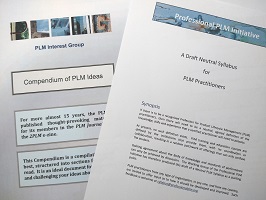|
PLM Interest Group |
||||||||||||||||||
|
|
|
|
||||||||||||||||
|
|
|
||||||||||||||||
|
|
|
|
||||||||||||||||
|
PLM Body of Knowledge
|
PLM Body of Knowledge
PLM has existed as a discipline since the turn of the century, and yet there is still no accurate, agreed definition of what PLM practitioners are supposed to know. The on-line world is full of conflicting theories and blogs, and it would seem that It would seem that PLM is the world's only job that is so complex that no-one can understand it.
The PLM Body of Knowledge Project runs alongside the drive for a PLM Profession, generating an industry-wide reference model that encapsulates best practice and right-first-time methods. |
|||||||||||||||||
|
PLM Body of Knowledge
|
The major challenge might seem to lie in defining and collating the massive amount of content that will be needed for a Body of Knowledge. PLM is a vast subject, with many complexities, with a seemingly irreconcilable mix of high-level business concepts and arcane technicalities. The PLM practitioner needs to know facts, but also needs to know what to do in many different situations. But in fact it will be equally challenging to define and agree a Structure for this new model that makes it useable. The embodiment of PLM - what it looks like in any given product-related business - is unique to the business concerned. There may therefore need to be several different ways of representing the same data. PLM practitioners can have many different roles, and they too may need to approach problems and answers in different ways. |
|||||||||||||||||
|
PLM Body of Knowledge
|
The PLM Manager, in any size of company, has to establish what should be done in PLM; and then to work out how to do it. The neutral Body of Knowledge should provide easy-to-use answers to these questions. The approach has to be interactive and iterative. No-one has all the answers, and the representation of the knowledge is unlikely to be right first time. There will need to be cross-industry discussion about this, in a formalised and well-structured way. The PLMIG has developed extensive expertise in dealing with these challenges, and can provide a working structure that makes it very easy for corporate users to get direct benefits. By 'cross-fertilising' ideas and solutions across a number of parallel implementations, participants get fixes for problems and share best practices. As these solutions are distilled into a neutral format, a parallel stream allows PLM organisations from all parts of the industry to review and refine the new knowledge. |
|||||||||||||||||
|
PLM Body of Knowledge
|
Some problems in PLM have not been solved by anybody - yet. They are either diffuse (top management acceptance; management of change): or extremely technical (a total approach to BOMs, for example). They need concerted effort, and the PLMIG workshop methodology provides the platform. So however intractable the issue, the 'user engine room' of PLM 2025-35 can generate the answer. Thus, creating the Body of Knowledge is just as valuable as referring to it once it has eventually been published. In some ways, more so. Your learnings and PLM issues are in the here and now, and leveraging your own learnings in partnership with other equally-experienced implementors is the fastest way to benefit. |
|||||||||||||||||
|
PLM Body of Knowledge
|
Governance Benefits
There is currently no "correct" way to run a PLM implementation, and every Head of PLM has their own way of doing it. But as user companies collaborate in the project, they will all see an overview of each other's management and ways of working. In doing so, they will implicitly help each other with PLM Governance. PLM Managers of well-run implementations should have a comprehensive set of documentation about its aims and operation. In order to align with each other, each participant will use PLMIG tools for internal benchmarking and assessment to produce a Navigation Model. The whole group the compares the Navigation Models to gain a common understanding of where everyone is. Thus, during the first few months, PLM Managers will implicitly share governance and management ideas with each other in a way that is likely to generate a new level of best practice. |
|||||||||||||||||
|
PLM Body of Knowledge
|
Everything will be explained at an on-line meeting on 30 September. The PLMIG will present the background and project structure, and participants can review it and add their feedback. If you would like to take part in that discussion then follow the link to the PLM 2025-35 page. If you would like to find out more about the programme, you can do so via plmknowledge@plmig.com. © Copyright 2025 PLM Interest Group |
|||||||||||||||||
| <<< Return Home | ||||||||||||||||||
|
|
|
|
||||||||||||||||
|
|
||||||||||||||||||





